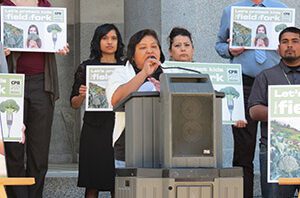For Immediate Release: May 6, 2015
Contact: Paul Towers, 916-216-1082 or ptowers@panna.org
Yesterday, the California Department of Pesticide Regulation released the much-delayed report on annual agricultural pesticide use in the state. Overall, pesticide use increased in the state increased from 2012 to 2013, including increases in cancer-causing 1,3 dichloropropene (trade name: Telone) and neurotoxic chlorpyrifos. Both pesticides are volatile and drift prone, and were some of the most frequent pesticides found in close proximity to California schools, according to a report released last year by the California Department of Public Health.
Several Central Valley counties continue to have the highest overall level of use in the state, along with agricultural counties on the Central Coast including Monterey and Ventura. The top ten counties in order of pounds of pesticides applied are Fresno, Kern, Tulare, San Joaquin, Madera, Monterey, Merced, Kings, Stanislaus and Ventura. Application levels in these top 10 counties ranged from over 6 million pounds in Ventura to more than 34 million pounds in Fresno. In total, 193 million pounds of pesticides were applied throughout the state, up from 186 million in 2012.
In response, Paul Towers, spokesperson for Pesticide Action Network, released the following statement:
“According to the data just released, hazardous and volatile pesticides continue to be heavily used in California. And in some cases, as with neurotoxic chlorpyrifos, the increased use is especially concerning. Vulnerable communities, especially farmworkers and children, are too often on the front lines of exposure.
The increased use of chlorpyrifos is disconcerting, particularly in the face of recent research from experts at the University of California Berkeley and Davis linking chlorpyrifos exposure to increased risk of ADHD and autism. And from last year’s report from the Department of Public Health, we know this and other harmful chemicals are widely used near schoolchildren.
While state officials have signaled some concerns about the continued use of hazardous and difficult-to-control pesticides like fumigants and chlorpyrifos, they have yet to commit to any firm reductions, a plan for action, and comprehensive investments in cutting-edge alternatives.”
###







